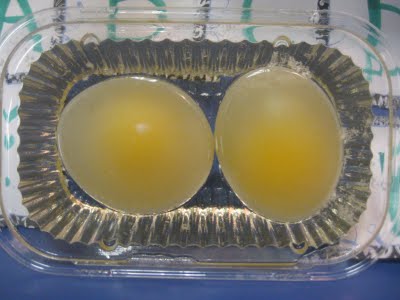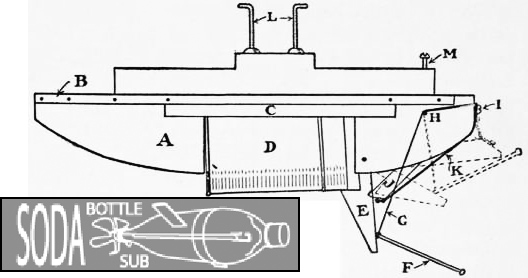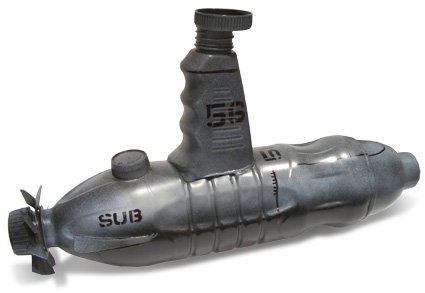
Judges determine the overall winner based on each team's score in the five different events.

The object of this Do-Ahead Project is to
design a container in which a hen's egg whose shell has been completely removed
can arrive intact after being sent through the U.S. Mail from your local post
office to this address:
Western Kentucky Physics Olympics
c/o Richard Gelderman
Department of Physics and Astronomy
Western Kentucky University
Bowling Green, KY 42101-1077
1. Each team must create a "naked egg" by removing the shell of a raw Grade A large hen's egg in a bath of vinegar, or other dilute acid. Simplified instructions for creating a naked egg are available on the web at Janice VanCleave's site. Without its calcium carbonate shell, the naked egg is surrounded by a membrane, made rubbery as a result of soaking in vinegar, that is marginally protective.
2. Pack the naked egg in the smallest container possible (smallest volume, smallest mass) to meet USPS regulations and ensure safe delivery. The USPS has the following regulations regarding the transport of raw eggs.
3. The size of the package must be bigger than 5 inches by 3 inches (according to US Post Office regulations) and smaller than 6 inches by 5 inches by 8 inches (such that it can fit into a standard rural-style mailbox).
4. Using the U.S. Postal Service's Standard Mail or Parcel Post, mail the naked egg to the designated address for arrival on or before Friday, February 17th, 2012. Late deliveries will not be judged.
5. The package must be at least double-wrapped to ensure that absolutely no liquid escapes. Enclose the naked egg inside nested leak-proof containers (e.g., Tupperware-style containers or sealed ziplock-style plastic bags).
6. A judge will unpack and remove the naked egg from all containers and wrappings. The naked egg must be able to be easily removed by the judges. A naked egg that is damaged in the normal process of removing it from its containers/wrappings will be judged as having failed to survive.
7. The naked egg will be inspected by the judges for remnants of it calcium carbonate shell and then will be placed on the tray of a scale so its mass can be measured. A naked egg that is too fragile to survive the inspection or weighing will be judged as having failed to survive.
8. Naked eggs that survive the transport, inspection, and measurement processes will be compete for top rankings. Teams whose eggs do not survive will be ranked beneath any team whose egg was successfully unpacked, inspected, and weighed. If a team's egg is not completely devoid of their shell, the final ranking will be at the lowest level of either successfully or unsuccessfully transported eggs. The score is calculated as the product of volume (cm3) and mass (g) of the delivered package.
9. All contestants will ensure that their entry works through the application of physics principles and generally follows the spirit of the competition.
Straightforward construction plans for a toy submarine that can dive then rise to the surface were published in A. Neely Hall's 1918 book Carpentry And Mechanics For Boys {please forgive the title's sexism}. Almost a century later, using modern materials, the HowToons.com site has published plans for a toy submarine constructed from empty soda bottles and powered by a rubber band. Search the web for inspiration from do-it-yourself and manufactured examples. Build a time machine and go back to the future for the kit shown in this streaming video.

1. Each team will design and construct a mechanically powered, untethered submarine vehicle to navigate the course provided -- start by floating in a normal orientation for a submarine, descend, self-propel over and under obstacles, and ascend to the finish area.
2. The submarine vehicle must have a defined front and rear and must be no more than 10-inches along that axis. In any other direction the submarine must not extend more than 6-inches, such that it can fit into a cylinder that is 10-inches long and 6-inches in diameter.
3. Teams may construct the submarine out of any non-electrical components. Parts can be custom machined items, re-purposed components, or purchased items. The vehicle may be decorated as the team sees fit, though no points are awarded for aesthetics.
4. Any pieces of the craft that come off during the test,regardless of whether the separation was intentional, must be retrievable from the tank within 60 seconds of the conclusion of the that run. For instance, it would not be acceptable to dump sand or some liquid other than water as a means to change to vehicle's bouyancy.
5. During the registration period on the day of the 2012 Physics Olympics, each team must submit their submarine to the judges for inspection. Vehicles that are unsafe or do not meet the specifications may be scratched from the competition.
6. The craft will be tested in a large glass tank provided for this event by the generous folk at the Bowling Green pet and aquarium store, Fishey Business. The tank measures 96-inches long by 18-inches wide with water that is 22-inches deep.
7. Teams will be have the opportunity for three runs during the competition. Each run will begin with the rearmost end of the vehicle touching the starting end of the tank and end when the vehicle is on the water's surface completely within the goal area comprised of the last 12-inches at the other end of the tank.
8. There are two obstacles that will limit the passage of a vehicle through the tank.
9. Scores shall be based on the following rubric:
| floats horizontally, without pitching into a vertical position | |
| moves forward in the water | |
| reaches far end of tank | |
| submerges | |
| resurfaces | |
| clears initial "sink-hole" trap | |
| passes underneath "ceiling" trap | |
| passes cleanly under entire "ceiling" without touching ceiling | |
| resurfaces on other side of "ceiling" trap | |
| upon resurfacing, vessel settles into horizontal position |
10.
11. All contestants will ensure
that their entry works through the application of physics principles and
generally follows the spirit of the competition.

An earthquake has bee detected and you
are being asked to use the physics of wave propogation to determine
its location. Your team will be divided into two groups.
The first group of two members of the team will be given basic
information about the detection of the earthquakes and background about
the propogation of waves, with instructions to produce a written plan to
allow the remaining two teammates to use the data for this earthquake
to locate the epicenter.
The instructions regarding this event are not released until it begins, so everyone is on equal footing.
Activity is the key word for this competition, with the goal being for each team to achieve the desired result as quickly as possible.The situation is designed to reward teamwork and common sense thinking as well as knowledge of physics.
Every team will come away with smiles and good memories regardless of how well they master the particular challenge.
Teams will receive 7 questions to complete within 15 minutes. The teams can divide the work in any way they see fit, but only one answer per question per team will be accepted. Answers will be judged according to how many orders of magnitude the team's answer is from the judge's solution. The lowest score wins -- 0 points awarded for the answer accepted by the panel of judges, with 1 point scored per order of magnitude from the accepted value.
Examples of Order-of-Magnitude Quiz questions include:
How many electrons enter the starter motor when a new, full-sized pickup starts?
How many times would a tire of a Ford Taurus rotate when driven from NYC to LA?
Estimate the number of gallons of gasoline used annually by all the cars in the USA.